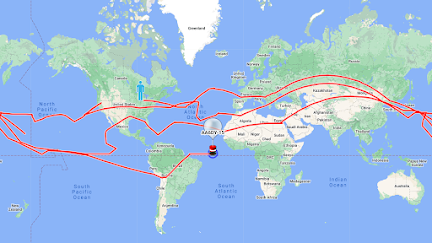Dean KK4DAS and I were at the high school on Thursday and Friday of this week for the construction (by the students) of the variable frequency oscillator stage of their analog, discrete, direct-conversion receivers for 40 meters. Most of the students have already obtained their Technician Class licenses, so they are already radio amateurs. Both the licensing classes and the receiver build are being done with the assistance of the Vienna Wireless Society.
A week earlier Dean and I had demonstrated how to build the oscillator stage using the Manhattan technique (isolation pads super-glued to copper clad boards), but this week was the first time these students were actually building anything like this themselves.
We deliberately did not "spoon feed" the students. We told them that while we would be on-hand to help, THEY would have to do the building. They would have to layout the pads on the PC board, select the parts (from a table set up by Dean), and do the gluing and soldering. We did not hand the students bags of parts, or prepared PC boards. This was not going to be a kit building session. We wanted this to be real homebrewing.
We had parts for 15 receivers. But on the first day there were more than 60 students. So four students per project. On the first day we actually ran out of soldering stations.
We cautioned the students against dawdling. We told them to get on with it, and to "make haste slowly." We also injected an element of competition into the build by announcing that the first team to achieve oscillation would win. (Prize still TBD).
By the end of the Thursday session, many boards had been built but there were not yet any oscillations. We reconvened on Friday afternoon -- Dean and I set up support/troubleshooting stations.
Right off the bat, one of the students came up with a board that he wanted to test. After one quick correction (enamel still on the oscillator coil leads), my frequency counter showed that it was oscillating. I fired up my DX-390 receiver and we heard the loud tone. We had a winner!
In the following hour or so, Dean and I did troubleshooting on about 10 more boards. We found some of the problems that we would all expect (because we have all made these mistakes ourselves!):
-- There were cold soldering joints. We showed the students how to properly solder -- usually they just had to re-heat some cold-looking connections.
-- A few of the Zener diodes and transistors were wired in backwards (been there, done that).
-- A few of the feedback capacitors were of the wrong values. Dean and I had brought some good caps, so the students were able to quickly swap out the parts. This was another good lesson.
-- There were a few wiring errors -- these were quickly corrected.
It was exciting. One-by-one we would hear the whoop-whoop as the DX-390 confirmed that another oscillator was OSCILLATING! The students really liked to HEAR the oscillations that they had created. We reminded them at the beginning that they would be taking DC from a little square 9 volt battery and turning it into RF that could (if connected to an antenna) be heard around the world, or in our case be used to receive signals from around the world.
We got eight of the oscillators going. We think the students will be able -- without much help from us -- to get the remaining seven oscillators going.
They learned a lot. They learned about the ease, flexibility, and usefulness of the Manhattan technique, and we think they could see how this represents a basic kind of PC board design. Their soldering skills improved a lot. And they learned how to troubleshoot: Is the layout correct? Are any parts wired in backwards. Is the soldering OK? Are any of the parts bad (or of incorrect values)? Most importantly, they learned that they CAN build circuits themselves, and actually get them working.
The real payoff came each time oscillation was achieved. The students were really amazed and pleased. I could tell that some of them weren't really sure their little device was actually creating the signal they were hearing. So while we listened to the DX-390, I asked them to disconnect and reconnect the battery. Confirmed. Oscillation! Smiles. It was really great.
Soon, after finishing up some PTO odds and ends, we will move on to the other stages. We'll probably do the bandpass filter or the mixer next. Then the AF amp. Then put it all together into a full receiver. We think each stage will get easier and easier to build as the students learn and improve their homebrewing skills and their self-confidence.








